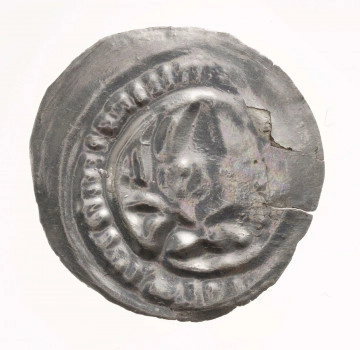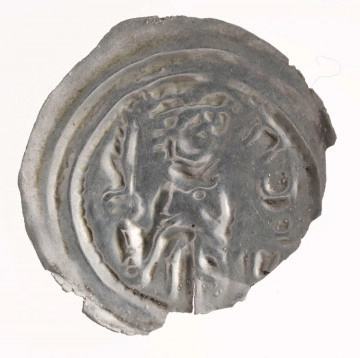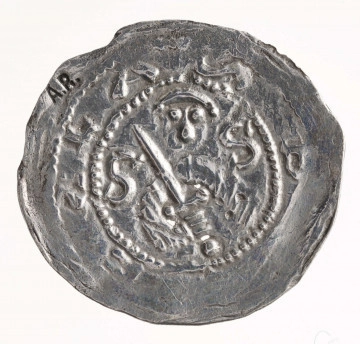
Bracteate of Mieszko III the Old
1181 — 1202
National Museum in Lublin
Part of the collection: Money on Polish territory in the Middle Ages
In 1173 Mieszko († 1202), the eldest of Bolesław the Wrymouthed's sons, succeeded to the Kraków throne and assumed supreme princely power in Poland, which was divided into districts. The title of Prince (dux maximus) adopted by Mieszko betrayed his ambitious political plans to strengthen the central power at the expense of the magnates and the district princes. It was to be achieved by increasing the wealth of the princely treasury through close supervision of the sources of income of the state, and by intensifying profits from the issue of money. That was done by a very frequent exchange of coins at a rate advantageous to the issuer, for example, four old denarii for three new ones. The scale of the undertaking required efficiently operating mints. Therefore, the prince put them under the management of Jewish financial specialists, who multiplied their efficiency by adapting the brakteat technology. It consisted in the production of coins on very thin silver plates with the use of a single stamp, under which several disks were put simultaneously. The double-sided denarii in use were soon replaced by single-sided denarii, i.e., brakteates (Latin bractea – plate). A remnant of the activity of Jewish minting entrepreneurs are coins with Hebrew inscriptions which had not been recorded in Poland until that time. Mieszko's fiscal policy aroused dissatisfaction of the magnates and district princes, who deprived him of his supreme power in 1177. Later, Mieszko regained the Kraków throne several more times, but failed to restore the importance of the central power. From the last quarter of the 12th century, the right to issue money, which had previously been ascribed to him, was taken over by the mighty and local princes. One of them was Mieszko, who, having lost his supreme power, minted coins in the Greater Poland region.
Several dozens of types of brakteates are connected to the prince. The chronology of many of them is unknown. One of them is the brakteate presented here, with the Hebrew inscription ‘bracha’ (blessing) running through the middle, separating the representation of the half-figure of the ruler in profile and a bird with a prominent beak, most probably an eagle as the symbol of the power of the prince.
Tomasz Markiewicz
Author / creator
Dimensions
cały obiekt: diameter: 16,7 mm
Object type
numismatic
Technique
stamp minting
Material
silver
Creation time / dating
Creation / finding place
Owner
The National Museum in Lublin
Identification number
Location / status

1181 — 1202
National Museum in Lublin

1181 — 1202
National Museum in Lublin

1164 — 1170
National Museum in Lublin
DISCOVER this TOPIC
Castle Museum in Łańcut
DISCOVER this PATH
Educational path